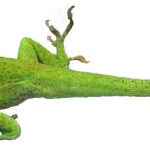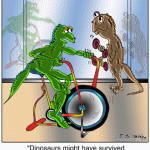lizard
A reader sent me the following question:
"How does a lizard grow a new tail?"
This was a very timely question as new research has shed light on this very phenomenon. A team of experts at Arizona State University led by Dr. Kenro Kusumi and colleagues have been studying limb regeneration in lizards.
Green anole lizard (Anolis carolinensis) with tail a new tail (image credit: Hutchins et al./PLoS ONE)
The green anole lizard (pictured above) can lose its tail when captured by a predator. They are then able to regrow their tails, although they do not look quite like the original. Dr.…
Have you ever been walking through the forest and thought to yourself, "Damn, its loud here...it's really, really hard to hear anything anybody else is saying"? Well, maybe that's what prompted Terry J. Ord and Judy A. Stamps, respectively from Harvard and UC Davis to investigate lizard exercise routines.
You ask: What do lizard calisthenics and communication have in common? Patience, grasshopper.
Dinosaurs also might have survived if they weren't eaten by giant snakes.
A noisy environment makes it particularly challenging for animals to detect communication signals from far away. In this…
Whiptail lizards are a fairly ordinary-looking bunch, but some species are among the strangest animals around. You might not be able to work out why at first glance, but looking at their genes soon reveals their secret - they're all female, every single one. A third of whiptails have done away with males completely, a trick that only a small minority of animals have accomplished without going extinct.
Some readers might rejoice at the prospect of a world without males but in general, this isn't good news for a species. Sex has tremendous benefits. Every fling shuffles the genes of the two…
In the White Sands National Park of New Mexico, there are three species of small lizard that all share white complexions. In the dark soil of the surrounding landscapes, all three lizards wear coloured coats with an array of hues, stripes and spots. Colours would make them stand out like a beacon among the white sands so natural selection has bleached their skins. Within the last few thousand years, the lesser earless lizard, the eastern fence lizard and the little striped whiptail have all evolved white forms that camouflage beautifully among the white dunes.
Erica Bree Rosenblum…
When danger threatens many lizards can detach their tails, leaving them behind as decoys in the hope that the predator will attack it rather than the lizard itself. But the tail doesn't just lie there as bait. For half an hour after they've been severed, the disembodied tails perform a complex dance, flipping, lunging and jumping up to an inch in the air. These acrobatics serve to distract the predator even further.
For the first time, Timothy Higham and Anthony Russell have studied the movements of severed gecko tails to understand how they can move in such complex ways without any input…
We think of spiders as fearsome hunters, spinners of webs and treacherous mates, but construction workers? Yes, that too. Some groups of spiders - trapdoor and wolf spiders - dig tunnels that they use to ambush passing insects. But these tunnels can also provide shelter and accommodation for other animals, including one of the rarest of Australia's lizards - the pygmy blue-tongue lizard. It seems that the lizard's survival depends entirely on the spiders.
The pygmy blue-tongue is a native of South Australia. It's so rare that zoologists thought it extinct for over 30 years and it re-emerged…
Well, not really. Artist Carel Brest van Kempen timelapsed stills of an acrylic painting to show his work process. It's remarkable how quickly the anole comes to life!
I especially enjoy watching the glazes go on and come off - each time he blots out part of the painting, I think, "oh NO!" But that's because I work in watercolor, which is pretty near irreversible. Acrylic is much more forgiving.
tags: Lepidodactylus buleli, new species discovered, Vanuatu gecko, reptiles, Ivan Ineich, Natural History Museum Paris France
French scientist, Ivan Ineich, displays a never-before-seen species of gecko at France's Natural History Museum in Paris. This gecko, formally described with the Latin name, Lepidodactylus buleli, was born in Paris from an egg that was removed from the rainforest canopy on the west coast of Espiritu Santo, one of the larger islands of the Vanuatu Archipelago, east of Australia in the South Pacific Ocean.
IMAGE: Francois Mori (AP Photo) [larger view].
According…
Via GTDA comes this mesmerizing time lapse video demonstrating the efficiency of ant recruitment:
Clearly, neither the man nor the bull below is headed for anything good in their attempt to walk on water,
and for that matter, neither is this poor, bristling cat,
but what about this reptile?
Unbelievably, this lizard actually can walk on water! And without using any surface tension tricks like insects do, either. No, whereas a human puts his foot into the water and sinks, this lizard has a very low mass and a very large surface area on his feet, allowing him to "run" on water as long as he moves quickly enough. For this lizard, that's about 10 miles-per-hour. As opposed to a human, who…
Scientists release seemingly harmless Italian Wall Lizards on a deserted South Adriatic island in 1971... and return to find walking, talking, boccie playing super-lizards! That is the headline that would have been written if researchers from the University of Massachusetts Amherst had waited only a few more years.
In truth however, the scientists discovered that these non-indigenous lizards had undergone remarkable evolutionary changes in only 36 years as they adapted to the new habitat. Duncan Irschick, a biologist from UMass Amherst explained, "Striking differences in head size and shape…
Geckos are nature's champion climbers. With remarkable ease, they can scamper across ceilings and up smooth vertical surfaces, and they do so at speed. A vertically running gecko can cover 15 times the length of its body in a single second. So far, scientists have focused their attention on the gecko's amazingly adhesive feet but a new study demonstrates the importance of a neglected piece of their climbing gear - their tails. Geckos use their tails to stop themselves from falling, and to land safely if they do.
A gecko's foot is a marvel of biological engineering. Rather than relying on…
Fascinating BBC footage of geckos coaxing leafhoppers to feed them honeydew. The lizards tap their feet or bob their heads, and the insect dutifully tosses them a bead of delicious tree sap. This definitely qualifies as bizarre zoology.
Have you ever noticed that your friends who make out with giant poisonous lizards never have diabetes? Now we know why!
As it turns out, gila monsters, a type of large, carnivorous, poisonous lizard native to the Southern U.S. and Northern Mexico have a kind of hormone in their salivary glands called Exendin-4, which causes humans and gila monsters alike to produce extra insulin in response to a rise in blood sugar. The hormone is very similar to a human hormone called GLP-1, only it lasts longer.
Come on in a little closer, baby. I don't bite...
The new drug, a synthetic version of…
This month marks Carl Linnaeus' 300th birthday and biology textbooks still look much the way he imagined they should. Linnaeus is the father of the ranking system of classifying the living world. You might remember kingdom, phylum, class, order, genus, species from the back of your hand in 9th grade biology class. Indeed, this system has stood up surprisingly well for almost two and a half centuries despite revolutionary advances in other scientific fields like medicine, where we now know that flu is not caused by a small gnome living in your stomach. Unfortunately for Linnaeus' legacy,…
A Chinese born, Paris-based artist hailed for his groundbreaking work that helped pave the way for a new generation of young artists in China is on the defensive after his most recent installation at the Vancouver Art Gallery. His work "Theatre of the World" features snakes, lizards, scorpions and a variety of dangerous insects trapped together inside a cage shaped like a turtle shell. The artist calls it a mirror of society's conflicts. Sadistic eight year olds call it a a rip-off of a favorite Saturday afternoon pastime. Regardless, it may be short lived as the SPCA has determined that the…
In honor of St. Paddy's Day, a tribute to being green.
Northland Green Gecko, naultinus grayii
Green Lynx Spider, peucetia viridansGreen Hermit Hummingbird, phaethornis guy (we think)
Green Grasshopper, campylacantha olivacea
A new species of clouded leopard was identified today in the jungles of Borneo. In fact, over 400 new species of animals have been discovered in the rain forests of Borneo since 1994.
Most of the species shown below were found through the World Wildlife Fund's (WWF) spectacular Heart of Borneo Initiative.
Bornean Clouded Leopard, neofelis diardi
Catfish with suction cups on its belly and protruding teeth
Lizard - new species of skink
(By far our favorite), Unidentified "Mystery Mammel"


